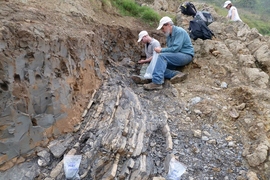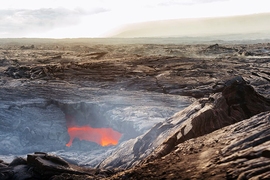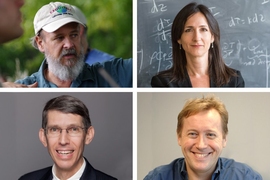Professor Emeritus Samuel A. Bowring, a longtime MIT professor of geology, died on July 17 at age 65.
Known for his exceptional skill as a field geologist and for innovatons in uranium-lead isotopic geochronology, Bowring worked to achieve unprecedented analytical precision and accuracy in calibrating the geologic record and reconstructing the co-evolution of life and the solid Earth.
No dates, no rates
A favorite aphorism, “No dates, no rates,” appeared in many of Bowring’s lectures and talks — meaning, to fully understand the past events preserved in the rock record you have to understand their timing. One of his earliest major contributions, which transformed what geologist know about the early evolution of the Earth, was his work in the 1980s on the Acasta gneiss complex, a rock body in northwestern Canada, pushing back the date of the oldest-known rocks to 4.03 billion years. The granitic samples he collected from an outcrop on an island in the remote Acasta River basin turned out to be rare remnants of the Earth’s earliest crust.
“What is more important about the Acasta gneiss complex than its 4.03 billion year age alone is its character, which Sam recognized and documented,” said Paul Hoffman, Harvard University Sturgis Hooper Professor Emeritus of Geology and career-long Bowring collaborator and friend. Hoffman explains that the Acasta rocks, paired with Bowring’s advocacy, fundamentally changed geologists’ understanding of continental formation. Prior to Bowring’s work the prevailing view was that the continents had steadily grown over geologic time. But, with these ancient gneiss samples, Bowring was able to characterize a complex history which predated the moment of their crystallization, which points instead to a process of ongoing crustal “recycling” — where rock near the Earth’s surface, through the mechanisms of plate tectonics, is subsumed and transformed by the mantle’s convective currents. According to Hoffman, “Sam’s fascination with the creation and preservation of continental crust never left him, whether he was at Great Bear Lake, the Grand Canyon, or the High Cascades in Washington State.”
Beyond studying the physical processes which shape the lithosphere, Bowring also sought to understand those which shape the biosphere. His work on sedimentary layers of the Precambrian/Cambrian boundary age determined the timing and rate of the pivotal biological event known as the Cambrian Explosion, beginning nearly 540 million years ago. He was able to establish that the Early Cambrian period which saw the most dramatic burst of evolutionary activity and animal diversity ever known — including the first emergence of chordates, brachiopods, and arthropods — spanned not 10 to 50 million years as was previously-believed, but instead lasted a mere 5 to 6 million years.
Longtime friend and colleague Tim Grove, the Robert R. Shrock Professor of Earth and Planetary Sciences at MIT, wrote of the achievement in a citation for the American Geophysical Union when Bowring was awarded the Walter H. Bucher Medal in 2016: “Sam showed that during this brief time interval more phyla than have ever since existed on Earth came into existence. This represents a truly profound and astonishing new discovery about how life evolved on Earth.”
Bowring also established the timing and duration of what has come to be known as “The Great Dying”: the largest of Earth’s five major mass extinctions, which marked the end of the Permian period and saw the elimination of over 96% of marine species and about 70% of species on land. Rocks collected by Bowring and collaborators from sites across China spanning the Permian-Triassic boundary revealed that the ecological collapse happened at breakneck speed — occurring in less than 30,000 years at a rate many times faster than previous estimates — and with little-to-no warning in geological terms.
A world-expert in uranium-lead isotopic dating, by 2002 Bowring began to see what he later termed “the double-edged sword of high-precision geochronology.” As the field experienced rapid advancements in precision, resolution, and quantitative stratigraphic analyses, many new techniques were developing in parallel. He recognized that without calibration and intercalibration of radioisotopic dating methods and quantitative chronostratigraphy, their accuracy and capacity as individual tools for understanding deep time were diminished. In response, he and colleague Doug Erwin conceived the EARTHTIME Initiative, a community-based effort to foster collaboration across the disciplines and eliminate inter-laboratory and inter-technique biases. Bowring’s common refrain to members to “check our egos at the door” reflected his unwavering goal to push the accuracy of geochronology to new levels, and helped the initiative build consensus and develop best practices and protocols. EARTHTIME continues to lead international workshops, expanding beyond topics of calibration and standardization to engage with the broader geoscience community, seeking to understand the rock record in ever more refined and nuanced ways.
“If the art of geochronology is the rendering of dates in their proper geologic context, Sam is our Michelangelo,” former MIT Department of Earth, Atmospheric and Planetary Sciences (EAPS) department head and close friend and colleague Tom Jordan said of Bowring. “He has always insisted that knowing what you are dating and why are as important as fixing the date itself; that the precision of absolute dating is most powerful when samples can be placed precisely in section.”
Bowring’s interest in the applications of tracer isotopes to examine Earth systems also extended to their utility in tracking environmental contaminants. His lab has developed methods for not only tracing naturally-occurring sources and establishing natural regional baselines, but also for documenting variations which correlate with anthropogenic inputs associated with urbanization and industrialization.
A dedicated teacher and mentor
Bowring joined the faculty of EAPS at MIT in 1991 where, in addition to fostering the careers of over two dozen graduate students and postdocs, he demonstrated a career-long commitment to advancing undergraduate education. For more than 20 years Bowring served as a first-year and undergraduate advisor, eventually being named a Margaret MacVicar Faculty Fellow in 2006 by the Institute program which recognizes faculty for, “exemplary and sustained contributions to the teaching and education of undergraduates at MIT,” and later earning the MIT Everett Moore Baker Memorial Award for Excellence in Undergraduate Teaching in 2007. He was also deeply involved in helping to shape curricula, serving on the MIT Committee on Curriculum from 2007 to 2010. He also served as chair of the EAPS Program in Geology and Geochemistry from 1999 until 2002, at which time he became chair of the EAPS Undergraduate Committee, serving until 2015. As a field geologist, he took his keen interest in engaging students to off-campus venues, leading annual trips into the field which were fixtures in the department’s calendar — from western Massachusetts to Yellowstone to the Las Vegas desert.
“Sam was an exceptionally effective and dedicated undergraduate educator, having gone well ‘above and beyond’ for EAPS and our students,” recalls Grove. “He took on more undergraduate teaching than any other member of our department in the last 25 years and was deeply committed to the importance of training undergraduates in the field — providing students with hands-on experience and using real-world geology to inspire and teach fundamentals.”
Bowring also was instrumental in guiding Terrascope, a first-year learning community created jointly by EAPS and the Department of Civil and Environmental Engineering in 2002. Bowring became associate director of the program in 2006, going on to serve as director from 2008 to 2015. The nationally-recognized program, which has been the subject of several academic papers and has grown to become one of MIT’s largest first-year communities, asks students with diverse research interests to tackle complex, global problems involving sustainability, climate, and the Earth system in a series of team-oriented, student-driven classes. In 2013, Bowring and his coauthors described the innovative curriculum by saying, “Our emphasis is on using a multidisciplinary approach to show that understanding the geosciences … is important to the students' world view, whether they know it or not. We believe it is our responsibility to teach as many students as we can about the Earth system, and in our experience, Terrascope students have a greatly expanded consciousness about the Earth and humans’ effect on it.”
Born in Portsmouth, New Hampshire, on Sept. 27, 1953, Bowring was raised in Durham, New Hampshire, where he also later attended the University of New Hampshire. After graduating in 1976 with a bachelor’s degree in geology, he went on to study at the New Mexico Institute of Mining and Technology, where he earned a master’s in 1980.
At the University of Kansas, Bowring had the opportunity early on to work with PhD advisor Randall Van Schmus on a project in the Northwest Territories of Canada (NWT) — where he was first introduced to collaborator Hoffman — which laid the foundation for both his PhD and continuing studies in the NWT’s Proterozozoic Wopmay orogen after joining the faculty at Washington University in St. Louis (WU) in 1984. It was as an assistant professor at WU that Bowring made his seminal analysis of the Acasta gneiss from the region, along with Ian Williams from the Australian National University.
In addition to being named a member of the National Academy of Sciences and the American Academy for the Advancement of Science, Bowring, the Robert R. Schrock Emeritus Professor of Geology, was a fellow of the American Geophysical Union and was recognized by the organization with both the Norman L. Bowen Award and Walter H. Bucher Medal. He was also a fellow of both the Geochemical Society and the Geological Society of America.
He is survived by his wife of 30 years, Kristine M. (Fox) Bowring, two stepdaughters, Kelley Kintner and Sara Henrick, as well as his siblings, James Bowring, Joseph Bowring, and Margaret Ann Bowring-Price. At the family’s request, there will be no formal services.













